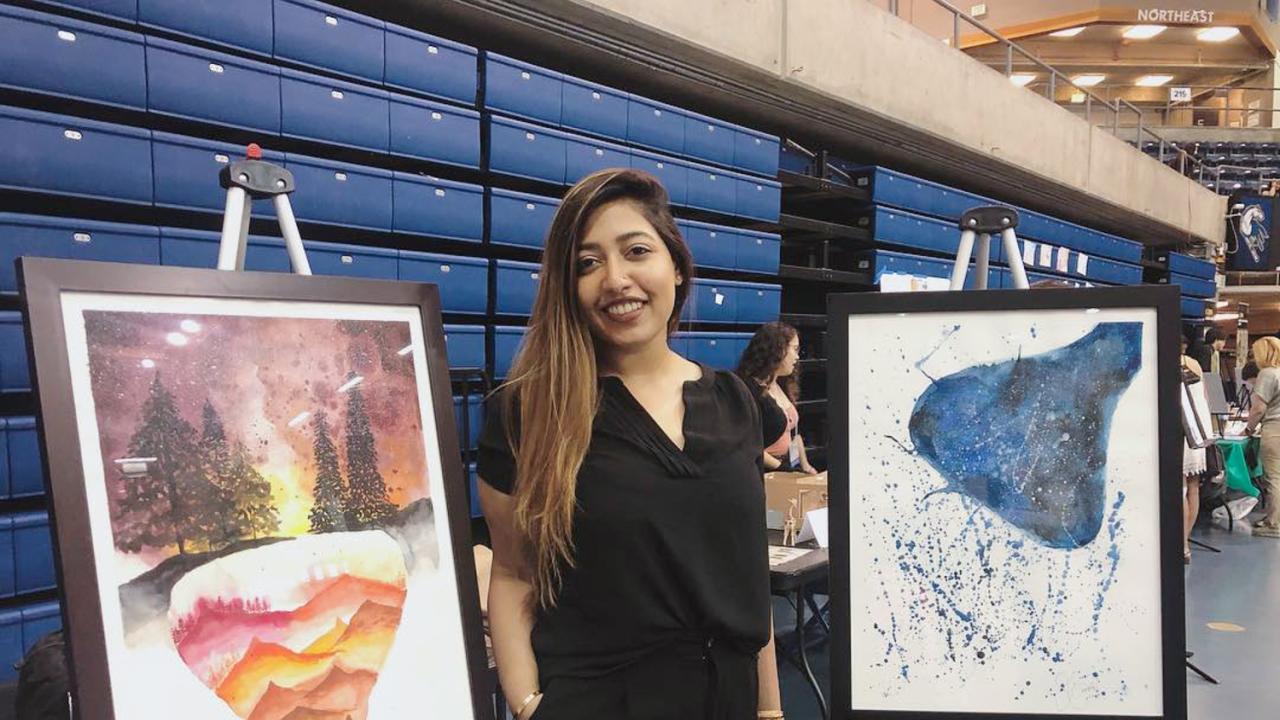
The Art of Harm Reduction: Sid Ganesh Searches for Substance Use Solutions
Quick Summary
- Sid Ganesh is the co-director of the Joan Viteri Memorial Clinic, a student-run clinic that offers healthcare to uninsured populations
- Her work with substance users has influenced both her research and art
- At the 30th Undergraduate Research, Scholarship and Creative Activities Conference, she displayed her watercolor series "The Art of Harm Reduction"
If you strolled through the ARC Pavilion during the 30th annual Undergraduate Research, Scholarship and Creative Activities Conference last spring, you’d find students from across campus displaying their latest research and projects. Among the mingling academics, you’d also find Sid Ganesh and three of her watercolor paintings.
The Art of Harm Reduction is a three-part series that attempts to “embody the lived experiences of persons who use drugs.” Each painting depicts a neuron rendered in a various state. In the first, the neuron, formed from flowers, tilts upwards, colorful spatters exploding from it in a blossom of ecstasy. In the second, the neuron is level. Within it, sunset-colored mountains sparsely dotted with trees (representative of dendritic spines) climb higher and higher to a star-filled expanse. In the final painting, the neuron looks like a wilted flower with blue and black dripping from it. The series is a pictorial progression of elation, dependence and addiction.
“I wanted it to feel overwhelming, like your entire cosmos depends on this substance,” said Ganesh, a senior double majoring in neurobiology, physiology and behavior and psychology, of the last painting.
The series serves as an homage to the vulnerable populations Ganesh regularly works with as co-director of the Joan Viteri Memorial Clinic, a UC Davis student-run clinic that offers healthcare to uninsured populations, people who use drugs, people involved in sex work, transgender populations and their families.
“The current rhetoric portrays substance use disorders as a moral failing and it is critical that we move away from that damaging narrative,” said Ganesh, who’s worked with the clinic for over three years.
“Instead of the distorted notion that people have somehow failed,” she continued, “we want it to be about hope beyond limits, radical love and unconditional positive regard.”

Managing pain through art
Ganesh’s interest in helping vulnerable populations stems from her own experience with an invisible illness. Since age 14, Ganesh has struggled with chronic pain. The difficulties doctors faced diagnosing the root of her chronic pain inspired Ganesh’s interest in the science of pain.
“It was probably the most devastating thing that’s ever happened to me, to be in pain for that long,” she said. “The reason I manage it is connection, family and privilege.”
Ganesh’s pain also inspired her to pursue art. She started drawing as a way to maintain motor function and finger dexterity.
“I can’t imagine managing any health challenge without connection, without this massive support system that I was blessed with,” she said. “That’s why I want to do work that is eventually leading back to intervention and leading back to answering questions like how do we support our community? The goal is to always place people at the center of the movement.”
In 2017, more than 70,200 people in the United States died from drug overdoses related to illicit drugs and prescription opioids, according to the Centers for Disease Control and Prevention. These deaths are preventable, according to Ganesh, but what’s needed is a personal understanding of the people suffering from substance use disorders.
Thanks to a 2019 Provost’s Undergraduate Fellowship, Ganesh now has funds to conduct a qualitative study that will examine the relationship between poverty and substance use in Sacramento County. The study will employ one-on-one interviews to gauge the community’s feelings and to put patients’ needs first.
“We need to really franchise these populations in their healthcare choices and one of the ways we can do that is by franchising them by the use of our research methodology,” said Ganesh. “It’s all about making sure that the people who are most affected by this structural violence are the ones dictating where the research is headed…and the solutions developed are based on what they want to see.”

The birthplace of creativity
As co-director of the Joan Viteri Memorial Clinic, Ganesh mentors new undergraduates, showing them the ways of the clinic. Undergrads perform vitals on patients, check and stock the pharmacy, dabble with electronic medical records and lead public health initiatives.
Ganesh’s experience with the clinic helped her familiarize herself with grant writing and research funding, which are critical to the scientific process. “How many undergrads have the privilege of working in a research institution where they can write their own grants and they have the opportunity to apply to multiple sources for funding?” she said. “I was very, very grateful to UC Davis for that process of teaching me how to think about funding as a prospective researcher.”
Like many other students, it took Ganesh some time to consider herself not just a student but a scientist. Imposter syndrome loomed over her shoulder.
“It’s really hard for students to make that transition to accepting that we’re all learning and that curiosity inherently involves uncertainty,” she said.
Over time, Ganesh learned not to balk at uncertainty but to accept it and to use it in a positive way.
“We’re not going to be creative thinkers without that,” she said. “Uncertainty is the birthplace of creativity.”

